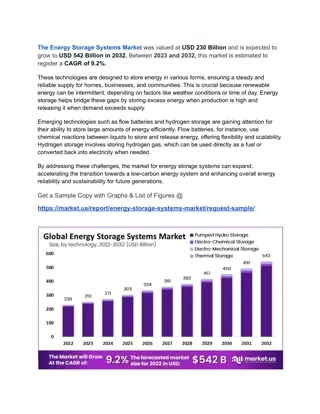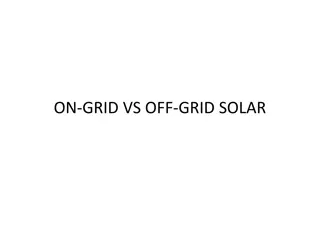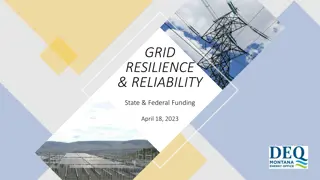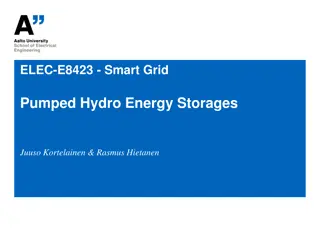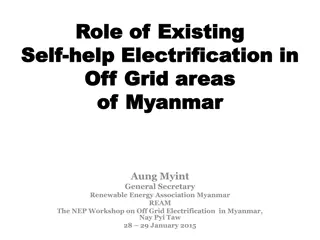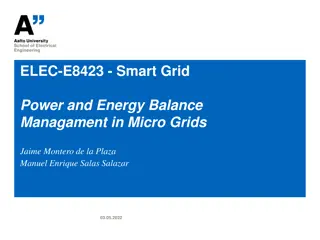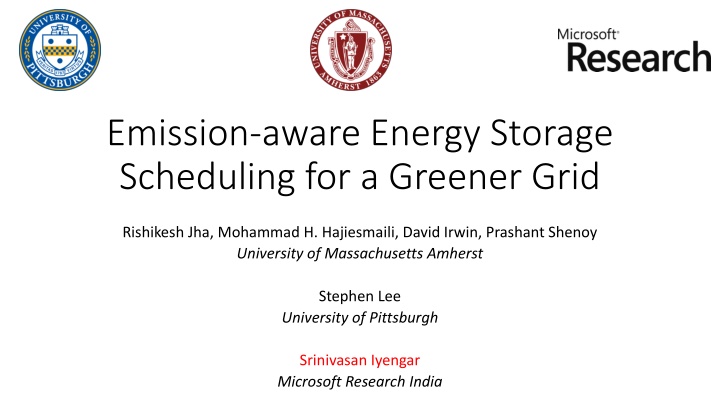
Emission-Aware Energy Storage Scheduling for a Greener Grid
This project focuses on optimizing energy storage scheduling to minimize grid-wide carbon emissions while considering operational constraints and fuel dynamics. It aims to reduce the carbon footprint and transition the grid to low-carbon sources, addressing key sustainability goals.
Download Presentation

Please find below an Image/Link to download the presentation.
The content on the website is provided AS IS for your information and personal use only. It may not be sold, licensed, or shared on other websites without obtaining consent from the author. If you encounter any issues during the download, it is possible that the publisher has removed the file from their server.
You are allowed to download the files provided on this website for personal or commercial use, subject to the condition that they are used lawfully. All files are the property of their respective owners.
The content on the website is provided AS IS for your information and personal use only. It may not be sold, licensed, or shared on other websites without obtaining consent from the author.
E N D
Presentation Transcript
Emission-aware Energy Storage Scheduling for a Greener Grid Rishikesh Jha, Mohammad H. Hajiesmaili, David Irwin, Prashant Shenoy University of Massachusetts Amherst Stephen Lee University of Pittsburgh Srinivasan Iyengar Microsoft Research India
Towards reducing our carbon footprint UN key sustainability goal a zero carbon economy Key Challenge: Transitioning grid to low-carbon sources Different fuel sources have different carbon footprint
Dispatch scheduling in electric grid Different generators are used based on demand Base load, load following, peak load plants Coal, Gas Coal, Hydro, Fuel Oil Nuclear, Coal Load profile for a day with two peaking events Different fuel sources are used for different load plants
Average and Marginal Carbon Intensity Average Carbon Intensity (ACI) Consider Coal, Natural gas, Nuclear and Hydro generate 25% each Thus, the ACI is (0.25*962.97) + (0.25*395.53) + (0.25*0) + (0.25*0) = 339.49 Marginal Carbon Intensity (MCI) If Natural gas is the marginal plant Then, MCI is 395.53 The marginal carbon intensity depends on the marginal power plant
Why Peak load reduction Emission reduction Mix of fuel type at any given time hinge on Change in demand: daily, weekly, seasonal, holidays, etc. Fuel availability: little rain -> less hydro Fuel Prices Grid load is known, but grid carbon footprint is not observable
Problem Statement Use energy storage for reducing emissions Problem Statement: Compute optimal scheduling of energy storage that minimizes grid-wide carbon emissions, respects the operational constraints of the grid and energy storage systems, given the dynamics in the marginal factor of available fuel types
Agenda Introduction Problem statement Robust Optimization Approach Evaluation Setup Experimental Results Related work Conclusion
EASS LP: Variables, Objective, Constraints Variable: f fuel types, n transformers, t time periods Emission Factor: Emission per unit of energy produced with fuel f: ?? Marginal Factor: Fraction of energy served by a fuel f at time t: ??(?) Schedule: The charge/discharge amount of storage ? at ?: ??? & ? ? = ?=1 Objective: Minimize overall emissions - ? ??(?) Constraints: Maintaining supply demand constraints grid and transformer level Storage constraints Rate, capacity, evolution
EASS Robust Optimization Approach Robust Optimization (RO) for decision making under load uncertainty Computationally tractable Probability distribution of uncertain variable (transformer load) not needed In deterministic optimization, the result often lies on constraint boundary. Easy to violate when uncertainty in factors Perturbation in uncertain factors considered in robust optimization. Result farther from infeasible space. More details on the use of RO in the paper
Inferring marginal factor Not directly observable Had to infer this using the distribution of price trace for each fuel Overall market price for electricity i.e. locational marginal price Used Gaussian membership function Get the mix of fuels used at any given time Normalization to get marginal factor Mean (Monthly Price of fuel) Locational Marginal Price of Electricity Variance (monthly price of fuel)
Evaluation Setup Dataset: Grid-scale trace-based evaluation Load dataset 2 years, 1341 smart meters (100 transformers = 25 to 750 KVA) Marginal Carbon Intensity ISO New England Experimental Settings: Parameter setting: Horizon 24 hours (5 min discrete intervals) Baseline Algorithms: Varying degree of assumptions PreDay: Previous day loads with online constraints Online LP: Day-ahead forecast load with online constraints Offline Optimal (Oracle): Perfect knowledge of load (Upper bound)
Load Forecasting under uncertainty Predicting load at transformer-level harder More stochasticity Net-metering for Solar adds to stochasticity However, there is seasonality Use of Autoregressive Neural Networks
Evaluation Impact of battery size # of hours to sustain maximum transformer load vs emission reduction Observations: Bigger battery = more flexibility in shifting -> Lower emissions (Max: 0.5 M kg/year) >1.2% gap with optimal for battery size smaller than 1 hour
Evaluation Impact of charge/discharge rate Battery capacity = 1 hour of max transformer load Observations: RO yields 13.9% emission reduction even at modest battery discharge rates 13.93% to 19.12% emission reduction for rate 0.25 and 1 respectively
Related Work Energy storage systems Grid Stability and cost arbitrage (Irwin et al. ACM Trans. CPS 17) Demand Response (Gnauk et al. ACM EDBT/ICTD 12) Load Forecasting ARIMA (Nguyen et al. IEEE ICPHM 17) Neural network (Kong et al. IEEE Trans. Smart Grid 17) Robust Optimization for scheduling Generator placement (Wang et al. IEEE Trans. Smart Grid 15) EV charging scheduling (Korlonko et al. IEEE Trans. Smart Grid 17) Storage sizing (Kazhamiaka et al. Acm eEnergy 18)
Conclusion Presented emission-aware energy storage scheduling using robust opt. Optimal decisions under uncertainty Transformer-level Load forecasting using autoregressive Neural Networks Accounts for stochasticity due to distributed solar Beats state-of-the-art techniques Grid-scale evaluation shows an improvement over baselines Reduction by >0.5 million kg in carbon emission (23.3% of overall)


